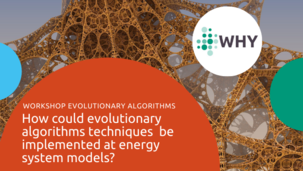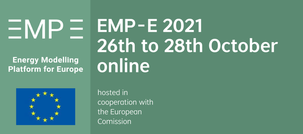| The Newsletter is not correctly? Please click: here |
|
WHY Newsletter
WHY is the next step in improving energy demand modelling to forecast the domestic sector’s energy consumption.
|
|
|
|
|
|
WHY Use Cases
|
|
The WHY project develops innovative methodologies and a toolkit for short and long-term household energy consumption modelling. Use cases benchmark these models ranging from local to European-wide energy grids. The WHY Causal Model contributes to improve the understanding of the human decision factors leading to energy demand patterns in the residential sector. These models will be used to create a set of computer programs that form the WHY Toolkit. The Toolkit will be integrated with leading ESMs to develop use cases that assess different policy scenarios: - Gniebing microgrid operation use case
- Energy cooperative operation and planning
- Energy Community Use Case
- 2030 & 2050 European energy strategy
- Global energy scenario
To find out more and see the video presentation of the use cases:
|
|
|
|
|
|
|
|
Defining Personas to Understand Stakeholder Needs: Stakeholder Requirements Analysis
|
|
The WHY Project follows the ambitious approach to improve the representation of household electricity demand in Energy System Models by applying a Causal Model to simulate the behaviour of residential consumers which will lead to the consumption of electricity. The first step into the development of the models and tools required to reach that goal is the involvement of stakeholders and the analysis of their requirements. Obtaining the stakeholder requirements is crucial both from a technical perspective (regarding the technical specifications of the WHY Toolkit like temporal and spatial resolutions, etc.) and non-technical perspective: regarding topics like the presentation of results or the general requirements for the toolkit.
WHY Partners conducted focus groups, interviews and applied surveys to better understand the stakeholder needs for the WHY Model Architecture and for the WHY Toolkit. The final work of the deliverable, aside from the Stakeholder Requirement Analysis, was consisted of the definition of the WHY Model Architecture. The architecture is described by Code-Elements, acollection of models and modules designated to perform a certain task within the WHY Model Architecture, which are linked by Interfaces. Interfaces are described by their corresponding data format and the data they will contain. Lastly the architecture contains Components, which are the key parts that make up the Code-Elements and are either Models, Data or Algorithms performing different tasks in the project.
The WHY Model Architecture presented in this Deliverable is a preliminary version that will be developed further in the course of the projects when the different elements will be developed. This preliminary version was developed to provide first insights into the inner workings of the WHY Toolkit.
You can download the full report by
|
|
|
|
|
|
|
|
Policy-driven and private interventions to foster the energy transition and Energy System Modelling
|
|
In order to be able to create all the models making up the WHY Toolkit, research was conducted to identify suitable approaches to tackle the different modelling challenges, which can occur during the creation of the WHY Toolkit. A major novelty of the WHY project is the consideration of people’s reaction to external stimuli (intervention) and how these reactions translate to their energy consumption behaviour. In order to better classify and understand these external stimuli, we identified five following types/categories of policy instruments: - Legislative and regulatory instruments
- Economic and fiscal instruments
- Agreement based or cooperative instruments
- Information and communication instruments
- Knowledge and innovation instruments
These policy instruments differ in how they aim to achieve a certain reaction in the policy targets. To get a better understanding of these instruments, the WHY consortium identified a multitude of national as well as international laws, initiatives, regulations, directives and more.
The analysis of models for different scales of energy systems provided a deeper understanding of energy consumption (thermal or electric) in different settings. They often work as a framework where multiple different, more or less detailed models, are included and soft-linked. 10 different already existing models have been analysed and discussed towards their relevance to WHY.
Read the full report by
|
|
|
|
|
|
|

|
|
EU Green Week: WHY Open Day Materials Available
|
|
Our first Open Day in the framework of the EU Green Week 2021 was an opportunity to engage with all stakeholders and interested citizens on...
|
|
|
|
|
|
|

|
|
Evolutionary Algorithm for Energy System Models
|
|
The Recording of the WHY Workshop "An introduction to evolutionary algorithms" is now available. The workshop focused on the best practices...
|
|
|
|
|
|
|
|
|
WHY Launches Telegram Bot for Household Use
|
|
WHY will launch a Telegram bot to monitor the daily energy demand of households. It will give advice on how to reduce electricity consumption.
In the next few months, the Telegram bot EcoBot will be released in the framework of the WHY project. The objective of EcoBot is to learn the habits of household members around the use of energy and use them to present some information to optimise their use of energy. At the same time, the bot will also ask relevant questions to try to understand the reasons behind the use of the energy and the willingness to invest time or resources on the energy transition.
The Telegram Bot was introduced at the at Zientzia Azoka 2021 Fair this year. Read about the experience here.
|
|
|
|
|
|
|
|
Improving demand-side modelling to inform ambitious climate policy in the European Union - workshop
|
|
On 19th of May, the WHY project held a workshop titled "Improving demand-side modelling to inform ambitious climate policy in the European Union" to engage with European energy experts. Spotlighting two different areas, Technical Aspects of Energy Modelling and Policy Interventions, stakeholders gave valuable insights for considering key aspects when modelling the residential sector. The stakeholders' input, representing both perspectives: technical and political, will help to determine and prioritise the most relevant interventions to consider in the WHY Toolkit. The report, available online on our website, provides a detailed synopsis of the event and summary of the stakeholder input.
|
|
|
|
|
|
|
|
Publication: User needs and modeller-driven improvements of energy system models
|
|
The EU-funded H2020 project SENTINEL (Sustainable Energy Transitions Laboratory) is developing a user-friendly online modelling platform, which, with its modular design, will respond to the needs of modelling users. Nevertheless, in order to design such platform it is of utmost importance to understand what these needs are, and whether there are visible differences between the expectations and requirements of modellers, in comparison to stakeholders, which make use of the modelling results.
SENTINEL researchers asked this question and conducted a study to investigate what are the differences between energy model improvements as perceived by modellers, and the actual needs of users of model results. Based on the literature review, expert interviews and an online survey they found out that user needs and ongoing improvements of energy system models align to a large degree, but some mismatches persist, especially in modelling of social, behavioural and political aspects, the trade-off between model complexity and understandability, and the ways that model results should be communicated.
The findings presented in the paper confirm the relevance to develop the causal models in WHY, which could address the shortcomings in modelling of behavioural and social aspects. Moreover, this study constitutes a good starting point to compare it with the findings of the WHY's WP1 and the stakeholders' requirement analysis. Stay tuned!
The publication presenting the results can be...
|
|
|
|
|
|
|

|
|
Conference: EMP-E 2021 - Re-Energising Sustainable Transitions in Europe
|
|
Energy System Modelling, Methods & Results to support the European Green Deal: 26th – 28th October 2021
EMP-E 2021 is an online conference
|
|
|
|
|
|
|

|
|
Conference: EEDAL-LS21 - Energy Efficiency in Domestic & Light Sources
|
|
EEDAL'22 will provide a unique forum to discuss and debate the latest developments in energy and environmental impact of households.
|
|
|
|
|
|
|
|
|
Supporting Consumer Ownership in Renewable Energy - SCORE Final Conference
|
|
The EU “Clean Energy Package” introduced “active consumers” as prosumers and their rights to produce, sell and share their own electricity in “Renewable Energy Communities” (RECs).
Currently, EU Member States are transposing the new rules (RED II & IEMD) into national law. The national rules differ widely especially regarding the “enabling framework” for RECs and the economic conditions for energy/electricity sharing. The SCORE Project's final conference will give you insights into - What lessons can be drawn from the SCORE pilots and follower city projects - especially for municipalities?
- How can individual consumers be encouraged to become prosumers and engage in energy efficiency?
- What opportunities and synergies can energy / electricity sharing provide for RECs?
- What business opportunities can they provide for professional actors from the energy sector?
|
|
|
|
|
|
|
|
|
|
WHY is the next step in improving energy demand modelling and predicting household energy consumption. The WHY project develops innovative methodologies and a toolkit for short- and long-term household energy consumption modelling. Use cases benchmark these models ranging from local to European sized energy grids. To bundle findings and outcomes of projects dealing with energy efficiency and energy consumption as well as modeling energy consumptions to support policies related to energy transition we seek to publish interesting news and articles. We seek articles and news from other projects and inititiatives, as well as by researchers or policy initiatives interested in distributing their results in an easy-to-understand language.
|
|
|
|
|
|
|
You are receiving this e-mail because you subscribed to WHY News via our website or because you have expressed your interest in receiving
information from us in the past. If you would rather not receive information, please, click unsubscribe. Please read our valid
Privacy policy.
You may also contact e.suba@climatealliance.org at any time to understand what information we have on file or request that this information either be updated or erased.
|
|
|
 The project has received funding from the European Union's Horizon 2020 research and innovation programme under grant agreement No 891943.
The project has received funding from the European Union's Horizon 2020 research and innovation programme under grant agreement No 891943.
|
|
|
|